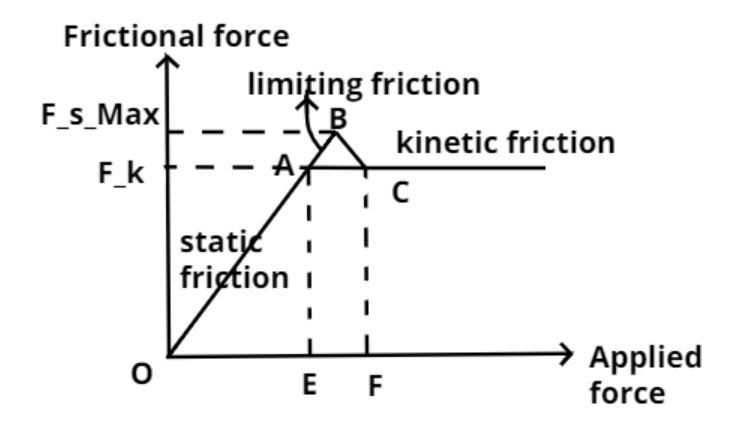
Maximum value of frictional force is called:
Answer
516.6k+ views
Hint – In this question use the concept that static-friction acts upon a body when it’s not in motion and is at rest, this friction helps the body retain its position unless an external force is applied to it. Limiting friction can be considered as a threshold friction that is applied in order to prevent motion when an external force is applied, kinetic friction comes into play when the external force has exceeded the value of limiting friction, the friction that is applied now is known as kinetic friction.
Step by step answer:

Static friction
Static friction is a self-adjusting force because it comes into play when the body is lying over the surface of another body without any motion.
So from point O to A it is called static friction.
Limiting friction
If we have not applied any force on a body to move the body, the frictional force also becomes zero. If we start applying force, with the applied force, the frictional force also starts increasing. This happens until the applied force is less than the limiting frictional force.
When that body overcomes the force of static friction, the maximum value of static friction is reached, which is known as limiting friction.
So, we increase the force from point E till point F.
As shown in the figure the maximum value of static friction is
So from point A to B it is called as limiting friction.
Kinetic friction
After the limiting friction, the frictional force is not going to increase further. At this stage, the object moves overcoming the frictional force which is at a constant value. This is called kinetic friction.
As shown in the figure after the limiting friction the frictional force is constant when we increase the applied force known as Kinetic friction denoted by
So to overcome this limiting friction kinetic friction comes into play from point B to point C thereafter it is constant.
So the maximum value of the frictional force is called the limiting frictional force.
Hence option (A) is the correct answer.
Note – In the graphical representation region OE is the region where the object is stationary holding its current position and the static friction is acting upon it, the region EF is where external force has been applied and the friction is opposing the change of state, after F the object is in motion and now kinetic friction is acting upon the object.
Step by step answer:

Static friction
Static friction is a self-adjusting force because it comes into play when the body is lying over the surface of another body without any motion.
So from point O to A it is called static friction.
Limiting friction
If we have not applied any force on a body to move the body, the frictional force also becomes zero. If we start applying force, with the applied force, the frictional force also starts increasing. This happens until the applied force is less than the limiting frictional force.
When that body overcomes the force of static friction, the maximum value of static friction is reached, which is known as limiting friction.
So, we increase the force from point E till point F.
As shown in the figure the maximum value of static friction is
So from point A to B it is called as limiting friction.
Kinetic friction
After the limiting friction, the frictional force is not going to increase further. At this stage, the object moves overcoming the frictional force which is at a constant value. This is called kinetic friction.
As shown in the figure after the limiting friction the frictional force is constant when we increase the applied force known as Kinetic friction denoted by
So to overcome this limiting friction kinetic friction comes into play from point B to point C thereafter it is constant.
So the maximum value of the frictional force is called the limiting frictional force.
Hence option (A) is the correct answer.
Note – In the graphical representation region OE is the region where the object is stationary holding its current position and the static friction is acting upon it, the region EF is where external force has been applied and the friction is opposing the change of state, after F the object is in motion and now kinetic friction is acting upon the object.
Latest Vedantu courses for you
Grade 10 | MAHARASHTRABOARD | SCHOOL | English
Vedantu 10 Maharashtra Pro Lite (2025-26)
School Full course for MAHARASHTRABOARD students
₹33,300 per year
Recently Updated Pages
Master Class 11 Economics: Engaging Questions & Answers for Success

Master Class 11 Business Studies: Engaging Questions & Answers for Success

Master Class 11 Accountancy: Engaging Questions & Answers for Success

Master Class 11 English: Engaging Questions & Answers for Success

Master Class 11 Computer Science: Engaging Questions & Answers for Success

Master Class 11 Maths: Engaging Questions & Answers for Success

Trending doubts
State and prove Bernoullis theorem class 11 physics CBSE

1 ton equals to A 100 kg B 1000 kg C 10 kg D 10000 class 11 physics CBSE

State the laws of reflection of light

One Metric ton is equal to kg A 10000 B 1000 C 100 class 11 physics CBSE

1 Quintal is equal to a 110 kg b 10 kg c 100kg d 1000 class 11 physics CBSE

Difference Between Prokaryotic Cells and Eukaryotic Cells




